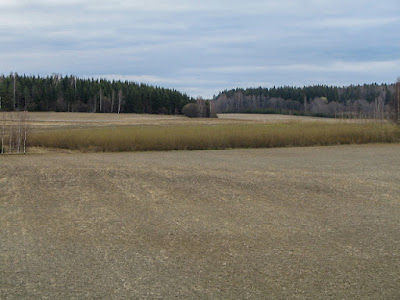Carbon stock in and Carbon fluxes at mineral soil arable lands in Finland
Carbon in agricultural fields belongs to the most topical research sectors for climate change in 2020s. Carbon husbandry is searching for new methods how to increase the Carbon stock in the soil. Also perennial crops and agroforestry methods have become more topical, like possibility of willow husbandry in new era farms (Picture 1).
The classification is based on the share of dry weight organic (humus) soil in the total soil dry weight. In mineral soil the organic share is less than 20 per cent. In mull soil the share is between 20 - 40 per cent. In peat soil the share is more than 40 per cent. The Carbon content (cc) in mineral soils in arable lands, is shown in Figure 1.
The Carbon concentration 35 g/kg (dry soil) equals 35 000 ppm (parts per million). It can be compared with the Carbon share in the dry biomass. That is quite accurately 500 000 ppm. Carbon share in mineral soils is clearly less than the Carbon content in for instance peat soils.
Besides Carbon content (cc, g C/kg dry soil) the Carbon stock (tn C/ha/15 cm) calculation needs the bulk density (bd, kg/m3) and the soil volume in 15 cm layer, in one hectare (V = 1500 m3). The bulk density is depending on Carbon content, on average, over the equation (1)
There is a clear tendency downwards. The future prediction can be done either with linear regression or with 2nd degree polynomial regression. In the linear option the coefficient of determination (R^2 squared) is 86.8 %, in the 2nd degree option 99.2 %.
The carbon stock equation (3) for the 2nd degree curve is
(3) c(t) = -0.0072923 * t^2 + 29.031 * t - 28826
The mineral soil arable fields Carbon stock level 61 - 67 tn C/ha/15 cm compares well with the average forest Carbon stock (tree stems, branches, foliage and roots) in Finnish forest lands. For the the year 2020 it is estimated at level of 36,3 tn C/ha.
By derivating the Carbon stock equation (3) we will get the Carbon flux (4)
(4) d (c(t))/ dt = -0.014585 * t + 29.031
The development of Carbon flux in mineral arable soils is shown in Figure 3.
Based on the data in Figure 1 the mineral soil arable fields in Finland have been in the status of Carbon emissions since 1990. In 2020 the calculated Carbon emissions flux (source flux) from average mineral soil arable land is -430 kg C/ha/a/15 cm. It also compares well with the Finnish forests. The calculated average carbon sink flux in 2020 into a forest hectare is 393 kg C/ha/a (Ref 3).
References
Ref 1: Luke. Carbon content in arable soil.
Ref 2: Heikkinen et al 2013. Declining trend of carbon in Finnish cropland soils in 1974–2009.
 |
| Figure 1. Development of Carbon concentration in mineral arable fields, in 15 cm topsoil layer. |
The Carbon concentration 35 g/kg (dry soil) equals 35 000 ppm (parts per million). It can be compared with the Carbon share in the dry biomass. That is quite accurately 500 000 ppm. Carbon share in mineral soils is clearly less than the Carbon content in for instance peat soils.
Besides Carbon content (cc, g C/kg dry soil) the Carbon stock (tn C/ha/15 cm) calculation needs the bulk density (bd, kg/m3) and the soil volume in 15 cm layer, in one hectare (V = 1500 m3). The bulk density is depending on Carbon content, on average, over the equation (1)
(1) bd = 1.52 - 0.280 * ln(cc/10) (ref 2)
Thus the Carbon stock (c) in arable mineral lands over one hectare in 15 cm depth is
(2) c = bd * V
The development of Carbon stock in Finnish mineral soil arable fields is shown in Figure 2.
 |
| Figure 2. Carbon stock in mineral soils arable lands. |
There is a clear tendency downwards. The future prediction can be done either with linear regression or with 2nd degree polynomial regression. In the linear option the coefficient of determination (R^2 squared) is 86.8 %, in the 2nd degree option 99.2 %.
The carbon stock equation (3) for the 2nd degree curve is
(3) c(t) = -0.0072923 * t^2 + 29.031 * t - 28826
The mineral soil arable fields Carbon stock level 61 - 67 tn C/ha/15 cm compares well with the average forest Carbon stock (tree stems, branches, foliage and roots) in Finnish forest lands. For the the year 2020 it is estimated at level of 36,3 tn C/ha.
By derivating the Carbon stock equation (3) we will get the Carbon flux (4)
(4) d (c(t))/ dt = -0.014585 * t + 29.031
The development of Carbon flux in mineral arable soils is shown in Figure 3.
 |
| Figure 3. Carbon flux in mineral soils arable lands |
Based on the data in Figure 1 the mineral soil arable fields in Finland have been in the status of Carbon emissions since 1990. In 2020 the calculated Carbon emissions flux (source flux) from average mineral soil arable land is -430 kg C/ha/a/15 cm. It also compares well with the Finnish forests. The calculated average carbon sink flux in 2020 into a forest hectare is 393 kg C/ha/a (Ref 3).
The Carbon fluxes from the arable mineral soils can also be referred to the value of Carbon dioxide emissions. At the end of 2020 it was 30 Euros per ton CO2 (Ref 4). It equals with 110 Euros per ton C. The (negative) value of arable soil Carbon emission is thus
-0.430 tn C/ha/a * 110 Euros/tn C = - 47.3 Euros/ha/a
Correspondingly, the (positive) value of average forest Carbon sink fluxes is
+0.393 tn C/ha/a * 110 Euros/tn C = +43.2 Euros/ha/a
References
Ref 1: Luke. Carbon content in arable soil.
Ref 2: Heikkinen et al 2013. Declining trend of carbon in Finnish cropland soils in 1974–2009.




Kommentit
Lähetä kommentti